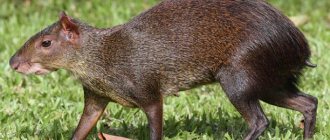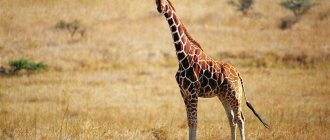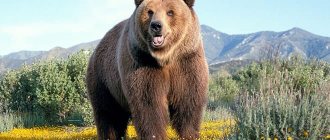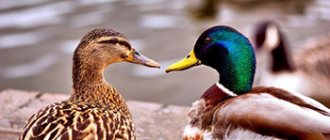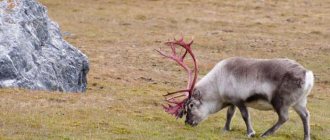In the dictionary Dictionary of foreign words
a, m., outdated. GIRAFFE, s, f.
1. shower An African ruminant with a very long neck and long legs. Giraffidae - pertaining to giraffe (giraffe), giraffes. How it gets to the giraffe (colloquial) - about someone who does not immediately understand what is said or told.
2. m., capitalized, astr. Circumpolar constellation North. hemispheres.||Avg. ANDROMEDA" title='ANDROMEDA, ANDROMEDA this, what is ANDROMEDA, ANDROMEDA interpretation'>ANDROMEDA, HERCULES" title='HERCULES, HERCULES this, what is HERCULES, HERCULES interpretation'>HERCULES, LION I, LYRA" title='LYRA, LYRA is, what is LYRA, LYRA interpretation'>LYRA I, PEGASUS" title='PEGASUS, PEGASUS is, what is PEGASUS, PEGASUS interpretation'>PEGASUS, PERSEUS" title='PERSEUS, PERSEUS is, what is PERSEUS, PERSEUS interpretation '>PERSEUS, SCORPIO" title='SCORPIO, SCORPIO is, what is SCORPIO, SCORPIO interpretation'>SCORPIO, PHOENIX.
Share the meaning of the word:
general description
The skin of a giraffe is very beautifully colored with irregularly shaped spots of dark brown color.
They are of different sizes and are separated by whitish spaces. The color of each individual is unique and, like fingerprints, has no analogues. The long - 1.5 m - neck has 7 vertebrae, like most mammals. The vertebrae, however, are very elongated in length.
A giraffe can have as many as 5 horns on its head - 2 true ones 20 cm long on the top of the head, 1 between the eyes (like a mythical unicorn), 2 “false horns” at the top of the back of the head. But most of these animals are two-horned.
This artiodactyl runs in only 2 ways:
- ambling, alternating alternately simultaneously either 2 left legs or 2 right legs;
- gallop. Now 2 front legs are thrown out at the same time, then 2 hind legs, again 2 front legs, 2 hind legs. Although it looks very clumsy, in this way the speed reaches over 55 km/h.
His vision is incredibly sharp. So he stands like a tower, overlooking the endless expanses of the savannah from the height of his gigantic height...
Giraffes are ruminant artiodactyls, like cows. They feed exclusively on plant foods. Most of all they like acacia thorns. One individual can eat up to 35 kg of greens or more per day.
Giraffes clean themselves with their tongue, licking their ears like domestic cats.
Giraffes are not very sentimental. They live alone or in small herds. Show moderate affection. Although mothers very selflessly protect their offspring.
From enemies - lions, leopards, hyenas, humans - the tallest mammal flees. Very rarely responds with combat. But fights happen with predators. Defending itself, the giraffe easily defeats even a lion with a blow of its hoof (up to 23 cm in diameter).
Under favorable conditions, a giraffe can live up to 30 years. The record for longevity of a male in captivity is 36 years.
Common types of giraffe
Based on patterns on the body and habitats, the following subspecies of giraffe are distinguished:
- The Nubian giraffe (G. c. camelopardalis) is a nominate subspecies, native to eastern Sudan and western Ethiopia.
— Advertising —
- West African giraffe (G. c. peralta) - found only in Chad.
- Kordofan giraffe (G. c. antiquorum) - lives in the west of Sudan and the Central African Republic.
- Reticulated giraffe (G. c. reticulata) - lives in northern Kenya and southern Somalia.
- Ugandan giraffe, or Rothschild's giraffe (G. c. rothschildi) - common in Uganda.
- The Masai giraffe (G. c. tippelskirchi) is a resident of southern Kenya and Tanzania.
- Thornicroft's giraffe (G. c. thornicrofti) - found in Zambia.
- Angolan giraffe (G. c. angolensis) - common in Namibia and Botswana.
- South African giraffe (G. c. giraffa) - lives in South Africa, Zimbabwe, Mozambique.
The Ugandan giraffe is distinguished by brown, large, irregularly shaped spots that are separated by wide white stripes. The Masai giraffe's spots are small and dark, five-pointed. Reticulated giraffes have unique spots; they are dark and polygonal, and between them there are narrow white stripes, which look like a net. The first three subspecies are very rare, and the Angolan giraffe was completely exterminated.
Giraffe breeding
Sexual maturity occurs at 4 years of age. The female is able to give birth for the next 15 years. The mating season occurs during the rainy season - July-September. At this time, peaceful and good-natured giraffes stage spectacular ritual fights.
The female's pregnancy, like that of all large animals, is long. It lasts about 14-15 months. Only 1 giraffe calf is ever born.
Within an hour the baby is standing well on his thin legs, and after another couple of hours he begins to get mischievous. The female takes care of the giraffe for up to one and a half years, while it sucks milk. Although he is able to pinch green grass already at the age of several weeks. At the same age, offspring are allowed into the herd.
And yet, what is the name of a baby giraffe?
If we talk scientifically, then in zoology the giraffe is an artiodactyl ruminant mammal. The babies of all artiodactyls are called calves. So, what is a baby giraffe called? Also a calf? But a goat gives birth to a kid, and a doe gives birth to a fawn. They are not called calves. This means that a giraffe can give birth to a baby giraffe, a giraffe, or a giraffe.
It is interesting that in the “Spelling Dictionary”, published by the Russian Academy of Sciences in 2001 under the editorship of V.V. Lopatin, there is the word “giraffe”, as well as in the “Big Explanatory Dictionary”, published in 1998 in St. Petersburg under Edited by A. S. Kuznetsov.
But if you are in doubt and don't want to get into trouble, just call him a baby giraffe. The photo shows how cute and cute they are.
Giraffe distribution
The giraffe is an inhabitant of the savannas of the African continent. It is found south and southeast of the Sahara and in southern and eastern Africa. Northern populations were exterminated by people in ancient times: during the times of Ancient Egypt, animals lived in the Nile Delta and on the Mediterranean coast. In the 20th century, the giraffe's range decreased significantly. The largest populations remain today in nature reserves.
Giraffe nutritional features
The giraffe is a herbivore. Due to its body structure and physiological characteristics, it can feed on leaves from the crowns of tall trees, where there is no competition. Giraffes' favorite tree is acacia. They cover the branch with their tongue, pull it towards their mouth and pluck the leaves, pulling their head back. A giraffe needs approximately 30 kg of food per day, which it absorbs within 16-20 hours. Interestingly, the food collection technique differs between males and females. Males eat foliage located very high, while strongly stretching and throwing back their heads. Females choose leaves that grow at the level of their body, and vice versa slightly lower their neck. The giraffe obtains the necessary moisture from leaves and can do without water for a week. But at one time the animal can drink up to 38 liters of water. To drink, the giraffe spreads its front legs wide so that its head lowers. In this position they become clumsy and vulnerable to predators. Giraffes can eat grass in a similar way, but this is a rare occurrence.
Natural enemies of the giraffe
Due to its impressive size, the giraffe has few natural enemies, and it defends itself from those predators that dare to attack it with the help of blows from its front hooves. Such a blow cuts the skull of any predator. For this reason, predators practically do not attack adult giraffes, but lions, leopards, hyenas and wild dogs can attack young individuals. Only 25-50% of young animals reach adulthood.
Curious and funny facts about giraffes
Source translation for mixstuff - Onriom
There are nine known subspecies of giraffes: West African (Nigerian), Nubian, Ugandan, Masai, reticulated, Kordofan, Thorneycroft's giraffe, Angolan and South African giraffes. They live in different regions of Africa, and each subspecies differs from the other in its characteristic color.
1. Giraffes can clean their ears with their own tongue.
2. In the wild, giraffes live no more than 10-15 years, but in a zoo, the average life expectancy of a giraffe is 25 years.
3. Due to their high growth, giraffes can notice a predator at a fairly large distance. Therefore, other animals on the savannah use giraffes as "watchtowers" or "lookout posts" to determine whether there are predators nearby.
4. It is very difficult to catch a giraffe by surprise while it is sleeping. Fearing predators, he is constantly vigilant, and his sleep lasts no more than two minutes. In general, a giraffe sleeps 30 minutes a day.
5. Giraffe is the tallest mammal.
6. Giraffes that live in the savannah, located south of the Sahara, mainly feed on acacia leaves.
7. Giraffes do not eat meat, preferring leaves and young shoots of bushes and trees. In one day, a giraffe can eat up to thirty-five kilograms of such food. Their favorite delicacy is the leaves and branches of the thorny acacia, which contains all the nutrients necessary for a growing giraffe, with the exception of salt and calcium. Leaves also contain a large amount of water, which makes searching for bodies of water less necessary. That's why giraffes love acacia so much!
8. Typically, a giraffe's blood pressure is about two to three times higher than that of a healthy person.
9. A giraffe can drink up to 12 gallons (55 liters; approx. mixstuff.ru) of water without a single break.
10. A giraffe can go without water longer than a camel. He can spend many days in the savannah before he takes a single sip. This helps him protect himself from the dangers that await other animals that are more dependent on water. Predators (lions, for example) like to wait for prey near bodies of water, knowing that it will definitely come for a drink. So the giraffe tries to do this as little as possible. In addition, in order to reach the water, the giraffe needs to awkwardly spread its front legs, and it is very difficult to see the enemy in this position. Moreover, run away from him. In addition, the giraffe has to be wary of crocodiles, which at any moment can emerge from the water, grab the victim and drag him under water.
11. In Atlanta, Georgia, it is illegal to tie a giraffe to a telephone or lamp post.
12. Newborn giraffes begin their lives by falling from a height of two meters.
13. Giraffes belong to the giraffidae family, which includes only one species - okapi.
14. Giraffes live in both desert savannas and wooded meadows.
15. A newborn giraffe is usually about two meters tall.
16. Giraffes have one of the highest blood pressure levels of any animal due to their tall stature and large heart.
17. Have you ever seen a giraffe faint? If the giraffe's neck did not include blood-pumping ventricles similar to those found in the heart, the animal would lose consciousness every time it lifted its head. The giraffe's heart is very large and heavy - 11 kilograms. Every minute he has to pump up to 75 liters of blood.
18. A giraffe can move only in two ways: walking and galloping.
19. Like people, giraffes have seven cervical vertebrae. Unlike humans, each vertebra in a giraffe is 11 centimeters in length. The neck of an adult giraffe is about 1.8 meters long, being extremely muscular.
20. Assuming that the giraffe’s ancestors must have been a camel and a leopard, Europeans once nicknamed it “camelpard.”
21. Giraffes are the tallest mammals in the world. Their growth gave them the advantage of spotting predators at long distances - especially in open grasslands. However, vigilance is only one of the giraffe's defense mechanisms. An attacked giraffe uses its powerful hooves to strike its opponent. And his blow is heavy. It is known to be able to crack a lion's skull.
22. Each giraffe's spots are unique. Thanks to this, one animal can always be distinguished from another.
23. You can often see small winged passengers on the backs of giraffes. These birds are called “cleaners” - they eat ticks attached to animals. Birds fill their stomachs, and giraffes get rid of parasites. Complete harmony. And, by the way, the beaks of these useful birds also act as “ear sticks” for giraffes. They eat earwax, getting deep into the ear. Yum!
24. The word "giraffe" comes from the Arabic "zarafa", which means "one who walks quickly." Giraffes not only walk, but also run fast. Their speed can reach 35 miles (56 kilometers) per hour! By comparison, the average person runs at a speed of 10 miles (16 kilometers) per hour. True, giraffes get tired quickly and are unable to maintain such a high speed for a long time. But if necessary, they can make a sprint and run away from a lion, for example.
